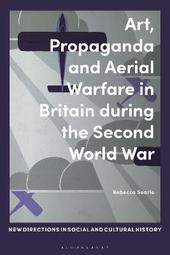
|
Art, Propaganda and Aerial Warfare in Britain during the Second World War
Hardback
Main Details
Description
The War Artists' Advisory Committee (WAAC) were responsible for the production of some of the most iconic images of the Second World War. Despite its rich historical value, this collection has been poorly utilised by historians and hasn't been subjected to the levels of analysis afforded to other forms of wartime culture. This innovative study addresses this gap by bringing official war art into dialogue with the social, economic and military histories of the Second World War. Rebecca Searle explores the tensions between the documentarist and propagandistic roles of the WAAC in their representation of aerial warfare in the battle for production, the Battle of Britain, the Blitz and the bombing of Germany. Her analyses demonstrate that whilst there was a strong correlation between war art and propaganda, the WAAC depicted many aspects of experience that were absent from wartime propaganda, such as class divisions within the services, gendered hierarchies within industries, civilian death and the true nature of the bombing of Germany. In addition, she shows that propagandistic constructions were not entirely separate from lived experience, but reflected experience and shaped the way that individuals made sense of the war. Accessibly written, highly illustrated and packed with valuable examples of the use of war art as historical source, this book will enhance our understanding of the social and cultural history of Britain during the Second World War.
Author Biography
Rebecca Searle is Principal Lecturer in the Humanities at the University of Brighton, UK. She is interested in interdisciplinary research on the histories of housing, capitalism, and war and conflict in the 20th and 21st centuries.
ReviewsRebecca Searle has written a fascinating account of the part that Kenneth Clark's War Artists' Advisory Committee (WAAC) played in reflecting and recording the British experience of the Second World War... Chapters on aircraft production, and on Britain's bombing campaign against German cities, are valuable contributions to areas that have been given little attention in our national narrative. Our understanding of the more familiar Battle of Britain and the Blitz, the subjects of Searle's other chapters, is enriched by her close attention to the visual storytelling that operated in conjunction with other mediations - whether via radio, newspapers or films - to shape the population's experience of war. * Times Literary Supplement * [T]his slim volume will engage and inform scholars interested in the art and propaganda in the modern state in general and twentieth-century Britain in particular. * Michigan War Studies Review * Rebecca Searle deftly combines social and political history, history of emotions, and visual studies to present an absorbing new book on Britain in the Second World War. This inter-disciplinary, expertly researched study presents a significant challenge to received histories about the role of official war artists through its skillful re-imagining of the relationship between fine art, experience, and propaganda. * Dr Lucy Curzon, Associate Professor of Art History, The University of Alabama, USA * Rebecca Searle's new book skillfully places the Second World War's official artists into the broader cultural history of the conflict, especially its central feature of aerial warfare. It enables us to understand better how artists themselves balanced the demand for propaganda with their own aspirations to create enduring work. Most important, by providing such a rich context for not only the production but also the wartime consumption of these paintings, she makes us want to turn to them again, able to appreciate them in new ways. * Susan R. Grayzel, Professor of History, Utah State University, USA * A really stimulating book that should be read by anyone interested in wartime culture. Drawing across images and archives and with a keen eye for the complexities of the past, Rebecca Searle gives us a host of new insights into the individual, institutional and cultural factors that conditioned the visual representation of aerial warfare in Second World War Britain. * Dan Todman, Professor of Modern History, Queen Mary University of London, UK * Rebecca Searle presents a fresh angle on the well-trodden subject of renowned art historian Sir Kenneth Clark. * Journal of British Studies *
|